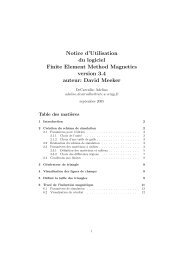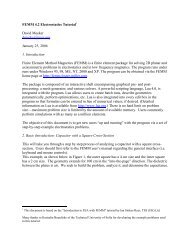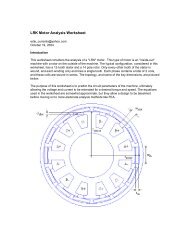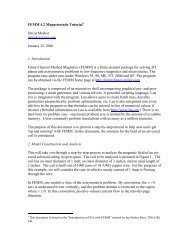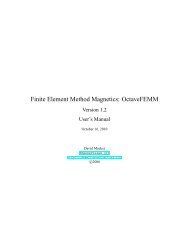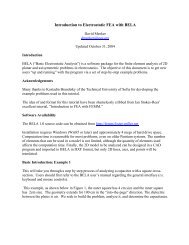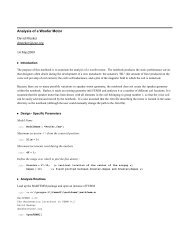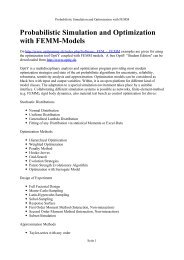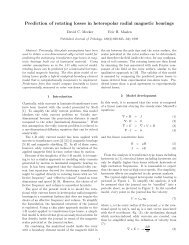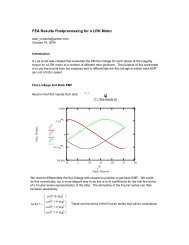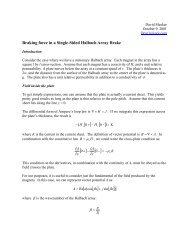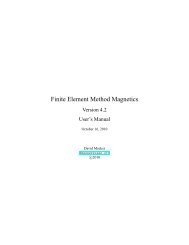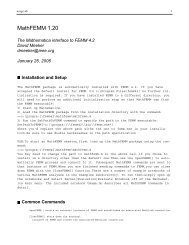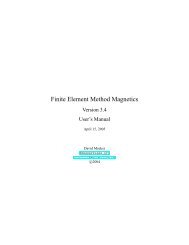FEMM Manual - Finite Element Method Magnetics
FEMM Manual - Finite Element Method Magnetics
FEMM Manual - Finite Element Method Magnetics
Create successful ePaper yourself
Turn your PDF publications into a flip-book with our unique Google optimized e-Paper software.
2. The Mixed boundary condition can used to set the field intensity, H, that flows parallel<br />
to a boundary. This is done by setting c0 to zero, and c1 to the desired value of H in<br />
units of Amp/Meter. Note that this boundary condition can also be used to prescribe<br />
∂A/∂n = 0 at the boundary. However, this is unnecessary–the 1 st order triangle finite<br />
elements give a ∂A/∂n = 0 boundary condition by default.<br />
• Strategic Dual Image This is sort of an “experimental” boundary condition that I have<br />
found useful for my own purposes from time to time. This boundary condition mimics<br />
an “open” boundary by solving the problem twice: once with a homogeneous Dirichlet<br />
boundary condition on the SDI boundary, and once with a homogeneous Neumann condition<br />
on the SDI boundary. The results from each run are then averaged to get the open boundary<br />
result. This boundary condition should only be applied to the outer boundary of a circular<br />
domain in 2-D planar problems. Through a method-of-images argument, it can be shown<br />
that this approach yields the correct open-boundary result for problems with no iron (i.e just<br />
currents or linear magnets with unit permeability in the solution region).<br />
• Periodic This type of boundary condition is applied to either two segments or two arcs to<br />
force the magnetic vector potential to be identical along each boundary. This sort of boundary<br />
is useful in exploiting the symmetry inherent in some problems to reduce the size of<br />
the domain which must be modeled. The domain merely needs to be periodic, as opposed to<br />
obeying more restrictive A = 0 or ∂A/∂n = 0 line of symmetry conditions. Another useful application<br />
of periodic boundary conditions is for the modeling of “open boundary” problems,<br />
as discussed in Appendix A.3.3. Often, a periodic boundary is made up of several different<br />
line or arc segments. A different periodic condition must be defined for each section of the<br />
boundary, since each periodic BC can only be applied to a line or arc and a corresponding<br />
line or arc on the remote periodic boundary.<br />
• Antiperiodic The antiperiodic boundary condition is applied in a similar way as the periodic<br />
boundary condition, but its effect is to force two boundaries to be the negative of one<br />
another. This type of boundary is also typically used to reduce the domain which must be<br />
modeled, e.g. so that an electric machine might be modeled for the purposes of a finite<br />
element analysis with just one pole.<br />
Materials Properties<br />
The Block Property dialog box is used to specify the properties to be associated with block labels.<br />
The properties specified in this dialog have to do with the material that the block is composed<br />
of, as well as some attributes about how the material is put together (laminated). When a new<br />
material property is added or an existing property modified, the Block Property dialog pictured<br />
in Figure 2.9 appears.<br />
As with Point and Boundary properties, the first step is to choose a descriptive name for the<br />
material that is being described. Enter it in the Name edit box in lieu of “New Material.”<br />
Next decide whether the material will have a linear or nonlinear B-H curve by selecting the<br />
appropriate entry in the B-H Curve drop list.<br />
If Linear B-H Relationship was selected from the drop list, the next group of Linear<br />
Material Properties parameters will become enabled. <strong>FEMM</strong> allows you to specify different<br />
26



